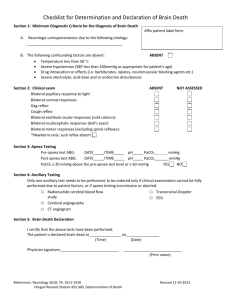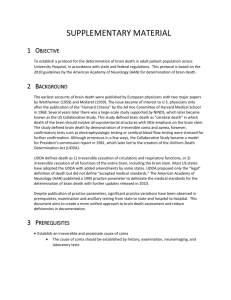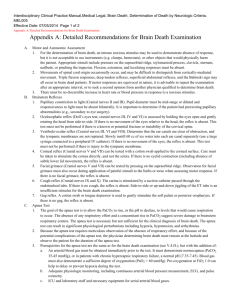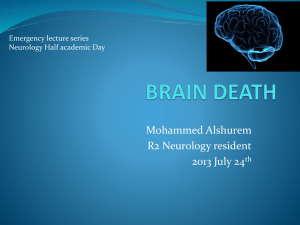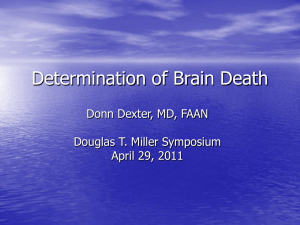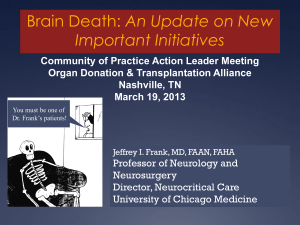- Organ Donation Alliance
advertisement
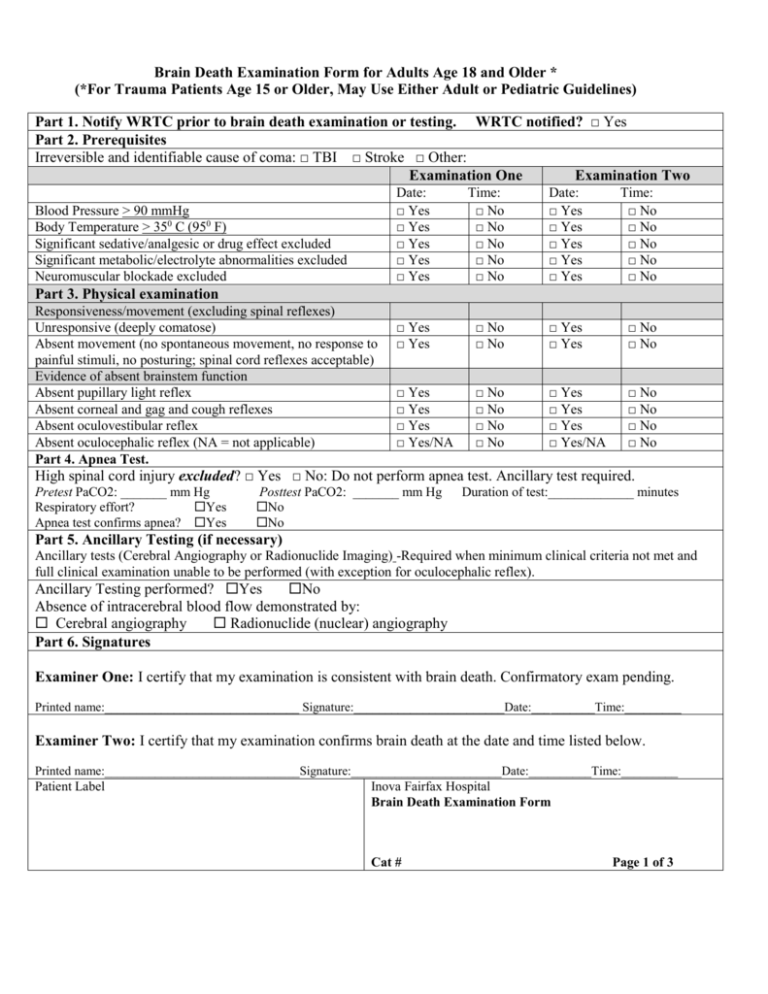
Brain Death Examination Form for Adults Age 18 and Older * (*For Trauma Patients Age 15 or Older, May Use Either Adult or Pediatric Guidelines) Part 1. Notify WRTC prior to brain death examination or testing. WRTC notified? □ Yes Part 2. Prerequisites Irreversible and identifiable cause of coma: □ TBI □ Stroke □ Other: Examination One Examination Two Blood Pressure > 90 mmHg Body Temperature > 350 C (950 F) Significant sedative/analgesic or drug effect excluded Significant metabolic/electrolyte abnormalities excluded Neuromuscular blockade excluded Date: □ Yes □ Yes □ Yes □ Yes □ Yes Time: □ No □ No □ No □ No □ No Date: □ Yes □ Yes □ Yes □ Yes □ Yes Time: □ No □ No □ No □ No □ No □ Yes □ Yes □ No □ No □ Yes □ Yes □ No □ No □ Yes □ Yes □ Yes □ Yes/NA □ No □ No □ No □ No □ Yes □ Yes □ Yes □ Yes/NA □ No □ No □ No □ No Part 3. Physical examination Responsiveness/movement (excluding spinal reflexes) Unresponsive (deeply comatose) Absent movement (no spontaneous movement, no response to painful stimuli, no posturing; spinal cord reflexes acceptable) Evidence of absent brainstem function Absent pupillary light reflex Absent corneal and gag and cough reflexes Absent oculovestibular reflex Absent oculocephalic reflex (NA = not applicable) Part 4. Apnea Test. High spinal cord injury excluded? □ Yes □ No: Do not perform apnea test. Ancillary test required. Pretest PaCO2: _______ mm Hg Respiratory effort? Yes Apnea test confirms apnea? Yes Posttest PaCO2: _______ mm Hg No No Duration of test:_____________ minutes Part 5. Ancillary Testing (if necessary) Ancillary tests (Cerebral Angiography or Radionuclide Imaging) -Required when minimum clinical criteria not met and full clinical examination unable to be performed (with exception for oculocephalic reflex). Ancillary Testing performed? Yes No Absence of intracerebral blood flow demonstrated by: Cerebral angiography Radionuclide (nuclear) angiography Part 6. Signatures Examiner One: I certify that my examination is consistent with brain death. Confirmatory exam pending. Printed name:_______________________________ Signature:________________________Date:__________Time:_________ Examiner Two: I certify that my examination confirms brain death at the date and time listed below. Printed name:_______________________________Signature:________________________Date:__________Time:_________ Patient Label Inova Fairfax Hospital Brain Death Examination Form Cat # Page 1 of 3 Brain Death Examination Form for Pediatric Patients Less than 18 Years and Older Than 7 Days (minimum 36 week gestation) *(For Trauma Patients Age 15 or Older May Use Either Adult or Pediatric Guidelines) Part 1. WRTC notified? □ Yes Part 2. Prerequisites Irreversible and identifiable cause of coma: □ TBI □ Stroke □ Other: Examination One Examination Two Date: Time: Date: Time: Blood Pressure greater than age appropriate minimum □ Yes □ No □ Yes □ No □ Yes □ No □ Yes □ No Body Temperature > 350 C (950 F) Significant sedative/analgesic or drug effect excluded □ Yes □ No □ Yes □ No Significant metabolic/electrolyte abnormalities excluded □ Yes □ No □ Yes □ No Neuromuscular blockade excluded □ Yes □ No □ Yes □ No Part 3. Physical examination Responsiveness/movement (excluding spinal reflexes) Unresponsive (deeply comatose) □ Yes □ No □ Yes □ No Absent movement (no spontaneous movement, no response to □ Yes □ No □ Yes □ No painful stimuli, no posturing; spinal cord reflexes acceptable) Evidence of absent brainstem function Absent pupillary light reflex □ Yes □ No □ Yes □ No Absent corneal and gag and cough reflexes □ Yes □ No □ Yes □ No Absent oculovestibular reflex □ Yes □ No □ Yes □ No Absent oculocephalic reflex (NA = not applicable) □ Yes/NA □ No □ Yes/NA □ No Part 4. Apnea Test. High spinal cord injury excluded? □ Yes □ No: Do not perform apnea test. Ancillary test required. First Apnea Exam Baseline ABG pH _______ PaCO2 _______ mm Hg Post Apnea Test ABG pH _______ PaCO2 _______ mm Hg Duration of test:_____________ minutes Respiratory effort? Yes No Apnea test confirms apnea? Yes No Second Apnea Exam Baseline ABG pH _______ PaCO2 _______ mm Hg Post Apnea Test ABG pH _______ PaCO2 _______ mm Hg Duration of test:_____________ minutes Respiratory effort? Yes No Apnea test confirms apnea? Yes No Part 5. Ancillary Testing (if necessary) Ancillary tests (Cerebral Angiography, Radionuclide Imaging, or EEG) -Required when minimum clinical criteria not met and full clinical examination unable to be performed (with exception for oculocephalic reflex). Ancillary Testing performed? Yes No Absence of intracerebral blood flow or lack of brain activity demonstrated by: Cerebral angiography Radionuclide (nuclear) angiography EEG Part 6. Signatures Examiner One: I certify that my examination is consistent with brain death. Confirmatory exam pending. Printed name:___________________________Signature:________________________Date:__________Time:_________ Examiner Two: I certify that my examination confirms brain death at the date and time listed below. Printed name:___________________________Signature:________________________Date:__________Time:_________ Patient Label Inova Fairfax Hospital Brain Death Examination Form Cat # Page 2 of 3 Information for Completing the Determination of Brain Death Assessment Clinical Criteria Details Notify WRTC (703-641-0100) The Clinical Team should notify WRTC of any patient on whom brain function testing is being considered. Date Date of examination. Time For children less than 18 years of age and 31 days of age or older (at least 36 week gestation): Two separate clinical exams must be performed at least 12 hours apart. For infants age 30 days or less and older than seven days of age (at least 36 week gestation): Two separate clinical exams must be performed at least 24 hours apart. For Adults Age 18 and older and Trauma Patients Age 15 and older, two separate exams must be performed by two physicians independently, with no specified time interval. For non-trauma patients less than 18 years of age, please use the Pediatric brain death examination form. Blood Pressure SBP should be greater than 90 mm Hg in adults & greater than the age appropriate minimum in newborns, infants, and children. Body Temperature Body temperature should be above 35 degrees C (95 F) prior to physician exam for adults and children. Neuroactive drugs worn off e.g. narcotics, sedatives, barbiturates, atropine, etc. Absence of Confounding Factors Significant electrolyte, metabolic or endocrine abnormalities. Physical examination requirements No responsiveness Patient should be deeply comatose with no responsiveness to noxious stimuli (e.g., supraorbital, sternal pressure). No movement Patient should not demonstrate any movement (spontaneously or to painful stimuli), including seizures, shivering, or posturing. Neuromuscular blocking agents and sedatives must be worn off. Spinal reflexes, including Babinski, are not indicative of brainstem function and hence may coexist with a diagnosis of brain death. Evidence of absent brainstem function Absent pupillary light reflex Bilateral absent pupil reflexes. (Note: pupil reflexes may be absent after eye injury, neuromuscular blockers, atropine, mydriatics, scopolamine, opiates.) Absent corneal, gag, cough reflexes Cough response best assessed by deep bronchial suction. Absent oculocephalic reflex (Dolls Elicited by rotating the head briskly. A normal response (present reflex) is conjugate eyes) deviation of the eyes to the side opposite of the direction in which the head is turned. May omit this test with known or suspected cervical spine injury. Absent oculovestibular reflex With head of bed at 30 degrees, instill 50mL of iced water into ear canal. Normal response (i.e., present oculovestibular reflex) is tonic deviation of the eyes toward the irrigated ear. Nystagmus in either direction should be absent in brain death. Perform an Apnea test per IFH Respiratory policy #5.2.13. See Policy for steps of procedure. Guidelines for clinicians: 1. Confirm prerequisites are met: 1) normotension, 2 ) normothermia (> 350 C), 3) euvolemia, 4) eucapnia (PaCO2 35-45 mm Hg), 5) absence of hypoxia, and 6) no prior evidence of CO2 retention (i.e. as seen in COPD, severe obesity) 2. Preoxygenate 3. Obtain baseline ABG 4. Disconnect ventilator while preserving oxygenation 5. Observe for respiratory movements for 8 – 10 minutes (may be shorter in pediatrics) 6. Criteria to abort test: presence of respiratory movements, systolic blood pressure <90 mm Hg or age appropriate minimum in pediatrics, SpO2 <85% for >30 seconds, or new cardiac arrhythmias. Send an ABG before reconnecting ventilator 7. If there is no respiratory effort, check PaCO2 by ABG, one or more times as necessary, after a minimum of 8 minutes (may be shorter in pediatrics) 8. Reconnect ventilator if PaCO2 meets apnea criteria or for criteria in #6 9. Positive test = patient is apneic and PaCO2 is greater than or equal to 60 mm Hg or 20 mm Hg increase in PaCO 2 over a baseline normal PaCO2, regardless of the time duration of testing 10. Negative test = respiratory movements are observed 11. Inconclusive test = PaCO2 does not meet apnea criteria or test aborted without checking PaCO2. Consider repeating test for a longer period of time or obtaining an additional confirmatory test Brain Death Examination Form 3 of 3
